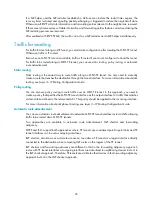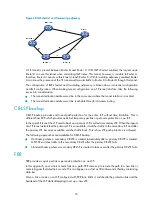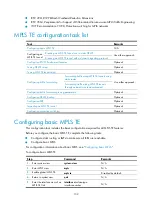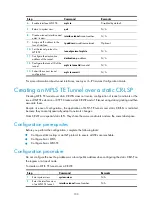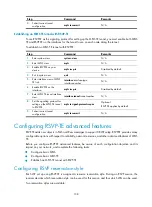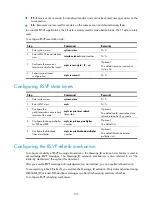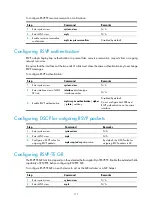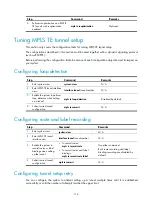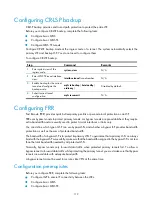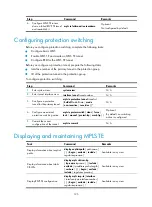
110
Step Command
Remarks
1.
Enter system view.
system-view
N/A
2.
Enter interface view of MPLS
TE link.
interface
interface-type
interface-number
N/A
3.
Enable the reliability
mechanism of RSVP-TE.
mpls rsvp-te reliability
Optional.
Disabled by default.
4.
Enable retransmission.
mpls rsvp-te timer retransmission
{
increment-value
[
increment-value
] |
retransmit-value
[
retrans-timer-value
] } *
Optional.
Disabled by default.
5.
Enable summary refresh.
mpls rsvp-te srefresh
Optional.
Disabled by default.
Configuring the RSVP hello extension
RSVP hello extension tests the reachability of RSVP neighboring nodes. It is defined in RFC 3209.
To configure the RSVP hello extension:
Step Command
Remarks
1.
Enter system view.
system-view
N/A
2.
Enter MPLS view.
mpls
N/A
3.
Enable global RSVP hello
extension.
mpls rsvp-te hello
Disabled by default.
4.
Configure the maximum
number of consecutive hellos
that must be lost before the
link is considered failed.
mpls rsvp-te hello-lost
times
Optional.
By default, the link is considered
failed if three consecutive hellos
are lost.
5.
Configure the hello interval.
mpls rsvp-te timer hello
timevalue
Optional.
The default is 3 seconds.
6.
Exit to system view.
quit
N/A
7.
Enter interface view of MPLS
TE link.
interface
interface-type
interface-number
N/A
8.
Enable interface RSVP hello
extension.
mpls rsvp-te hello
Disabled by default.
Configuring RSVP-TE resource reservation confirmation
Reservation confirmation is initiated by the receiver, which sends the Resv message with an object
requesting reservation confirmation.
Receiving the ResvConf message does not mean resource reservation is established. It only indicates that
resources are reserved on the farthest upstream node where the Resv message arrived and the resources
can be preempted.



